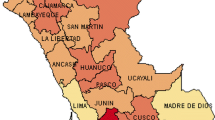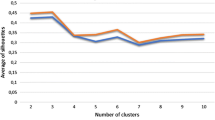Abstract
In the analysis of the competitiveness of the European regions a three-way approach is used to define indexes which prove to be a valid alternative and integration to the Regional Competitiveness Index (RCI). The STATIS method, which is a generalization of the Principal Component Analysis for three-way data, is applied to take into account the data structure in three macro-pillars (Basic, Efficiency, Innovation) which represent different facets of the competitiveness. STATIS searches for a common “compromise" of the macro-pillars by explicitly taking into account the similarity structure between both European regions and competitiveness indicators. The projection of the NUTS-2 European regions in a low-dimensional space spanned by the compromise allows to analyse similarities as well as disparities at regional level and provide useful and easy-to-read map to visualise both the regions and the indicators. The results largely reflect the 2019 edition of the RCI and its sub-indexes provided by Eurostat with the great advantage of not using an exogenous weighting system necessary in defining the RCI.










Similar content being viewed by others
Notes
NUTS = Nomenclature of Units for Territorial Statistics. The RCI follows the NUTS 2016 revision (https://ec.europa.eu/eurostat/web/nuts/background).
References
Abdi, H., & Williams, L. (2010). Jackknife. In N. Salkind (Ed.), Encyclopedia of research design (pp. 655–660). CA, Thousand Oaks: Sage.
Abdi, H., Williams, L. J., Valentin, D., & Bennani-Dosse, M. (2012). Statis and distatis: optimum multitable principal component analysis and three way metric multidimensional scaling. WIREs Computational Statistics, 4(2), 124–167.
Annoni, P., & Dijkstra, L. (2019). The EU regional competitiveness index 2019. Joint Research Centre: European Commission.
Annoni, P., & Kozovska, K. (2010). The EU regional competitiveness index 2010. Joint Research Centre: European Commission.
Dijkstra, L., & Poelman, H. (2012). Cities in europe: the new OECD-EC definition. Regional Focus, 1(2012), 1–13.
Escoufier, Y. (1980). Exploratory data analysis when data are matrices. In K. Matusita (Ed.), Recent development in statistical inference and data analysis (pp. 45–53). Amsterdam: North-Holland.
Gardiner, B., Martin, R., & Tyler, P. (2004). Competitiveness, productivity and economic growth across the european regions. Regional Studies, 38(9), 1045–1067.
Horn, R., & Johnson, C. (2006). Matrix analysis. Cambridge: Cambridge University Press.
Krugman, P. (1994). Competitiveness: A dangerous obsession. Foreign Affairs, 73(2), 28–44.
Rodrik, D., Subramanian, A., & Trebbi, F. (2004). Institutions rule: the primacy of institutions over geography and integration in economic development. Journal of Economic Growth, 9(2), 131–165.
Tukey, J. (1958). Bias and confidence in not quite large samples (abstract). Annals of Mathematical Statistics, 29, 614.
Acknowledgements
The authors wish to express particular thanks to Dr. Paola Annoni who provided useful information on the theoretical framework of Eurostat Regional Competitiveness. The authors thank the Editor and the referees for their useful comments and suggestions which helped to improve the quality and presentation of this manuscript.
Author information
Authors and Affiliations
Corresponding author
Additional information
Publisher's Note
Springer Nature remains neutral with regard to jurisdictional claims in published maps and institutional affiliations.
Appendices
Appendix 1
Tables 3, 4, 5, 6, 7, 8 and 9 are reported in this Appendix.
Appendix 2
Rights and permissions
About this article
Cite this article
Bocci, L., D’Urso, P., Vicari, D. et al. A Three-Way Approach for Defining Competitiveness Indexes of the European Regions (NUTS-2). Soc Indic Res (2021). https://doi.org/10.1007/s11205-021-02839-9
Accepted:
Published:
DOI: https://doi.org/10.1007/s11205-021-02839-9








